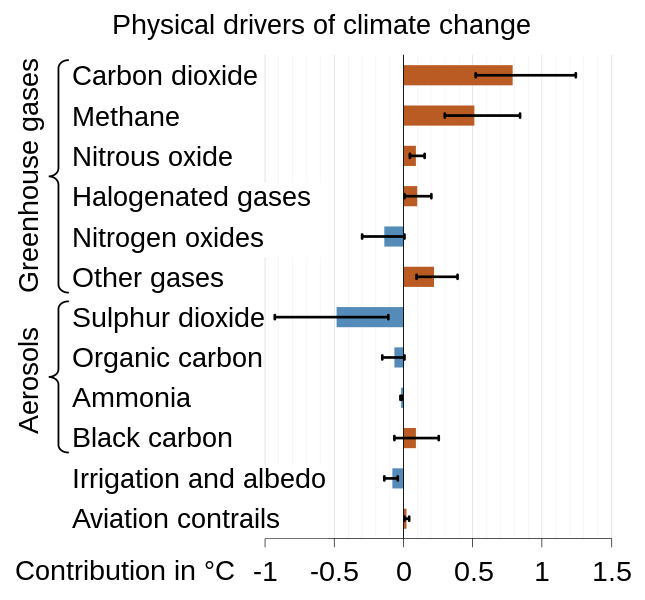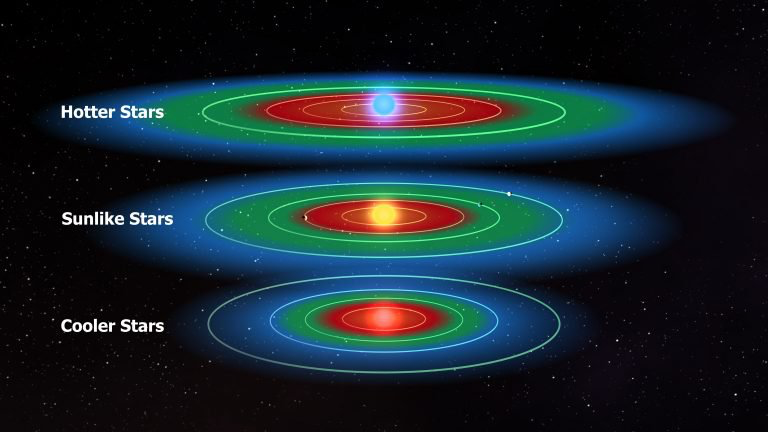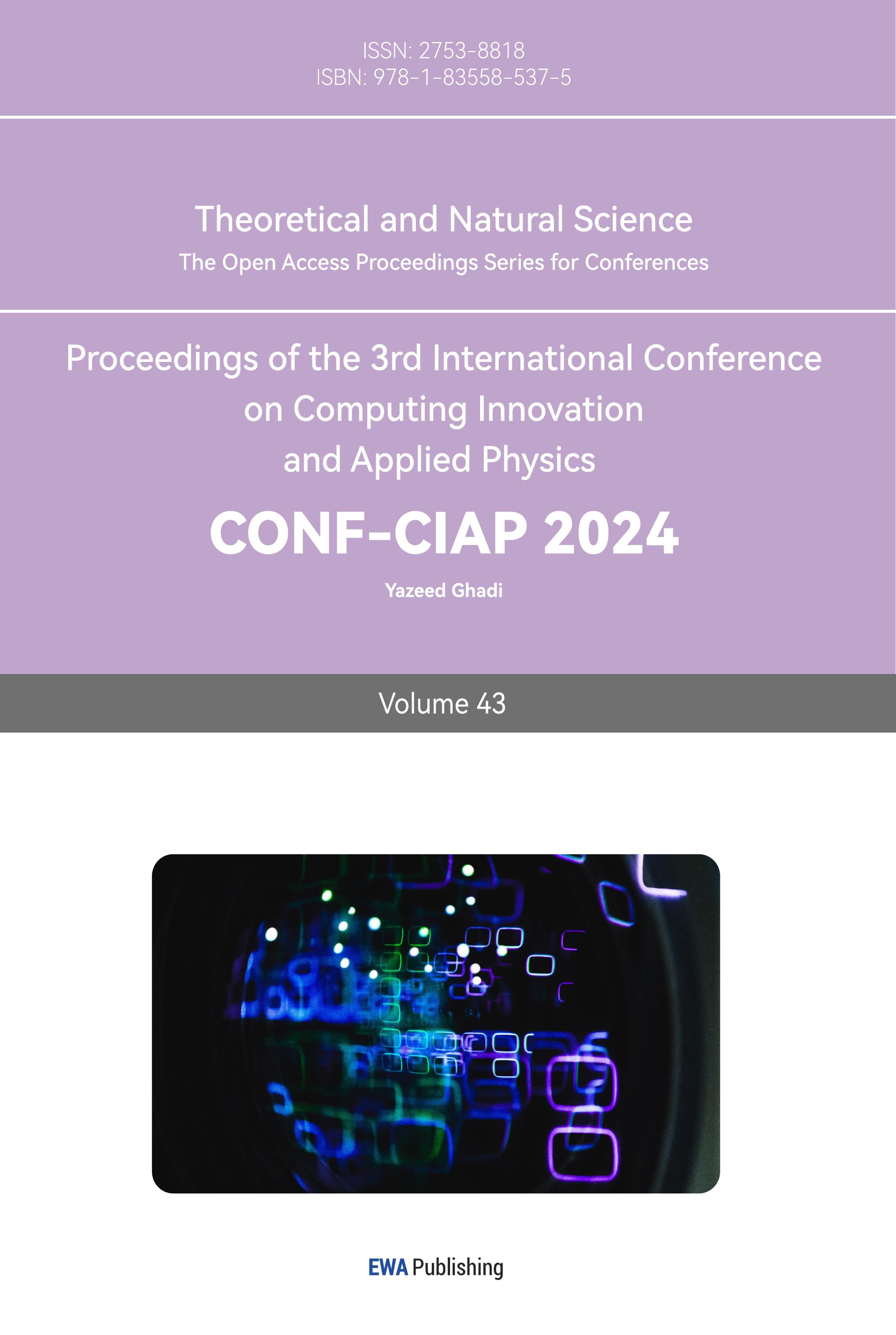1. Introduction
Research on the habitable zone and the habitability of exoplanets have been published extensively in various academic journals around the world. Such directions have been debated continuously for the past decade. There are two main reasons to study this topic, the first is to prepare for the future survival of mankind after the destruction of the Earth, and the other is to pursue the existence of extraterrestrial life. We wish to demonstrate different aspects of whether distinct exoplanets can be habitable and the conditions necessary for life to exist on exoplanets. Although humans have not yet discovered any extraterrestrial life or planets that perfectly meet the requirements for habitation, the increasing number of new discoveries that are additionally detailed about the crucial living conditions gives a new possibility for future humans to migrate to other planets.
2. The Factors That Will Influence The Temperature
The first point is about the atmosphere of the planets, it is directly related to the greenhouse effect, which occurs when the planet’s heat radiation builds up at the planet’s surface. Ingredients like carbon dioxide will intensify this phenomenon, and it will influence the whole climate of the planet. For example, Venus is a planet with a runaway greenhouse effect [1], which means that the greenhouse gases are too much to allow the planet to cool down to form liquid water by emitting long-wave radiation. In this situation, even though Venus is in the habitable zone of the sun, its temperature is still too high for living.
The greenhouse effect is closely related to the greenhouse gases.

Figure 1. Radiative forcing (warming influence) of different contributors to climate change through 2019.
As shown in Figure 1, we can see the main components of greenhouse gas. Use Venus as an example. Venus does not have a magnetic field, but it has an induced field, and this will resist the loss of carbon dioxide, therefore, Venus has a thick and toxic atmosphere filled with carbon dioxide, and it is shrouded in a thick yellow cloud with sulfuric acid which will trap the heat.
Table 1. The ingredient of atmosphere [2].
Element or molecule | Percentage in the lower atmosphere |
Carbon dioxide | 96.5% |
Nitrogen | Less than 3.5% |
Sulfur dioxide | 0.015% |
Argon | 0.007% |
In Table 1 we can see there are substantive amounts of carbon dioxide, and this is the main effect of the runaway effect on Venus. So, the thick atmosphere with large amounts of carbon dioxide will make the temperature on the planet extremely high which will become inhabitable.
The second point is the planet’s surface conditions. The planet’s surface is covered by different elements, such as water, ice, and rocks. The differences in this shroud will reflect different numbers of waves, and this is called the albedo of a planet. Albedo is a fraction of the sunlight that is diffusely reflected by a body. When we consider the albedo as a factor of the planet’s temperature, we usually consider the surface albedo. Surface albedo is defined as the ratio of radiosity Je to the irradiance Ee (flux per unit area). Use Earth as an example, the average albedo of the Earth is 0.3 [3]
Table 2. The albedo of different matter.
Surface | Typical albedo |
Open ocean | 0.06 |
Bare soil | 0.17 |
Greenhouse gas | 0.25 |
Ocean ice | 0.50-0.70 |
Fresh snow | 0.80 |
How the albedo affects the temperature, according to the definition, Ee always keeps the same, so when the albedo increase, the radiosity, the radiant flux leaving a surface per unit area, increase, so the energy emitted increase, the energy lost increase led to the temperature decrease or keep low.
The third point is the condition of the sun. For example, the type of the sun.

Figure 2. The graph to show the habitable zone
Green sections indicate the habitable zones that surround various types of stars. For cooler red-dwarf stars, their habitable zone is much closer. New research indicates that being this close to a red dwarf star could mean trouble for an otherwise habitable exoplanet.
We can see that the habitable zone is far from the star when the star is hot; and is close to the star when the star is cold. So, the type of the star will influence the habitable zone and influence the temperature. One of the reasons that will influence the temperature of the star is its mass. As the mass increase, the temperature increase. As we know the radius of the star will influence the luminosity of the star, and the luminosity will directly affect the temperature of the star, the change in star temperature will affect the temperature of the planet and affect its habitability.
3. Calculation Of Habitat Zone Of Toi-700 System
Let \( {L_{⋆}} \) be the luminosity of the star, \( {R_{⋆}} \) be the radius of the star, \( {R_{p}} \) be the radius of the planet, \( {T_{⋆}} \) be the temperature of the star surface, \( {T_{p}} \) be the temperature of the planet surface, \( A \) be the albedo of the planet, \( a \) be the orbital radius, \( {F_{⋆}} \) be the flux of the star, \( {P_{in}} \) be the incoming energy per unit time, \( {P_{out}} \) be outgoing energy per unit time.
\( {L_{⋆}}=4πσR_{⋆}^{2}T_{⋆}^{4} \) (1)
\( {F_{⋆}}=\frac{{L_{⋆}}}{4π{a^{2}}}=σ{(\frac{{R_{⋆}}}{a})^{2}}T_{⋆}^{4} \) (2)
\( {P_{in}}=(1-A){F_{⋆}}\cdot πR_{p}^{2} \) (3)
\( {P_{out}}=σT_{p}^{4}\cdot 4πR_{p}^{2} \) (4)
Because of the radiative equilibrium,
\( {P_{in}}={P_{out}} \) (5)
\( (1-A){F_{⋆}}\cdot πR_{p}^{2}=σT_{p}^{4}\cdot 4πR_{p}^{2} \) (6)
\( (1-A){F_{⋆}}=4σT_{p}^{4} \)
\( (1-A)σ{(\frac{{R_{⋆}}}{a})^{2}}T_{⋆}^{4}=4σT_{p}^{4} \)
\( a=\frac{{R_{⋆}}}{2}{(1-A)^{\frac{1}{2}}}{(\frac{{T_{⋆}}}{{T_{p}}})^{2}} \) (7)
According to the Gilbert et al.,
\( {T_{⋆}}=3480±135 K \)
\( {R_{⋆}}=0.420±0.031 {R_{⊙}} \)
Due to some atmospheric effects, such as the greenhouse effect, the habitat zone should be defined by the criterion \( 175 K \lt {T_{P}} \lt 270 K \) (Kaltenegger and Sasselov) [4].
Assume that the atmospheric effects on this planet are the same as on Earth - and thus the albedo of this planet is 0.3, which is the Earth’s approximate albedo [5].
The outer boundary of the habitat zone is
\( {a_{O}}=\frac{{R_{⋆}}}{2}{0.7^{\frac{1}{2}}}{(\frac{{T_{⋆}}}{175 K})^{2}}≈0.3234 AU \)
The inner boundary of the habitat zone is
\( {a_{I}}=\frac{{R_{⋆}}}{2}{0.7^{\frac{1}{2}}}{(\frac{{T_{⋆}}}{270 K})^{2}}≈0.136 AU \)
Therefore, the range of the habitat zone is \( 0.136 AU \lt a \lt 0.3234 AU \) ; and TOI-700 d is in the habitat zone since the orbital radius of TOI-700 d is 0.1633 AU [6].
4. Tidal Lock
4.1. What is a tidal-locked celestial body?
A tidal lock occurs when the rotation period of a celestial body is equal to or approximately equal to the period of revolution of it. This effect causes the celestial body to invariably face the other body in the identical hemisphere. A typical example is Earth and the Moon, nevertheless, the research below will demonstrate the tidal lock on planets and stars. Additionally, explain the relationship between habitability and tidal lock.
When a tidal lock occurs between a planet and a star, the planet is going to be split into two completely different hemispheres, with one forever facing the sun and another forever staying in darkness. Moreover, the two hemispheres have great temperature differences in that the side facing the star can be extremely hot, while the other side can be glacial. Liquid water is hard to find on this kind of planet, as it can be either vaporized or frozen. The necessary elements for a living cannot be satisfied. Subsequently, without the alternation between day and night, evolution and survival become difficult, particularly with our present body structure, it is exceptionally difficult for us to adapt to these disparate weather conditions and environments. Thus, for many years, astronomers strongly believed that tidally locked planets were unfit for human habitation. Nevertheless, some Astronomers suggested that humans may be able to live in the terminator line of tidally locked planets. [7] The Terminator line is a region between two hemispheres that is in a perpetual twilight. In this region, temperature and other elements can be more suitable for living, and the possibility of having liquid water can be also elevated.
4.2. Why explore the habitability of tidally locked planets?
Many studies have shown that Earth-like temperatures Planets in the galaxy are generally tidal-locked to their stars. The reason is that 70% of the suns in the galaxy are red dwarfs. They are cooler compared to other main sequence stars, so they present a reddish surface. Furthermore, they are two-thirds smaller in mass and diameter than our sun. Because of their small size, they have less gravity. Due to this, the distance between planets and red dwarfs is small hence more likely to cause tidal lock. Moreover, from the perspective of human survival, planets with smaller solar mass tend to have longer lifespans than the large ones, hence, humans may be able to exist longer on these planets, with less concern about planetary destruction.
4.3. Are tidally locked planets completely uninhabitable?
In fact, in recent years, astronomers have discovered the possibility and potential of future human habitation on tidally locked planets. The extreme temperatures on both hemispheres of the planets can be adjusted by other particular conditions.
Firstly, the thickness and elemental composition of the atmosphere are genuinely crucial and play a big role in regulating extreme weather in both hemispheres.[8] When the radiation from the red dwarf reaches the tidally locked planet, the wavelength of the radiation is not enough to penetrate through the planet’s atmosphere, for instance, on Earth 95% of the wave has a wavelength of 3-50 μm which is not able to reflect; this can greatly reduce the loss of heat because of the forming greenhouse effect. So that increases the possibility of warming up the cold hemisphere. Above that, a thick atmosphere reduces the entry of radiation, which further makes the hemisphere less hot during the day. Furthermore, the atmosphere radiates the absorbed radiation in all directions, making the temperature on the planet more balanced. In fact, this specific condition is hard to achieve as the atmosphere needs to be dense enough to transfer heat energy, nevertheless, humans cannot survive if it is too dense. Secondly, wind and ocean currents are exceedingly important for conducting and convicting heat [9] on a planet as well as the atmosphere, they redistribute heat on the planet’s surface, making the temperature and climate of the entire planet more habitable. The hot side can be cool down, and the cold side can be warm up. But in order to transport the heat efficiently and effectively, ocean currents and wind need to be running at an extremely high speed that is greater than the planet’s rotation speed. This effect is called the super-rotate. [10]
Of course, other conditions such as the percentage of carbon dioxide, nitrogen, and oxygen in the air, and the composition of the planet’s surface can reduce or increase the habitability of tidally locked planets. The good news is that astronomers have discovered that such planets if adapted to certain conditions can be able to inhabit and also, they have worked out what those conditions are. The list of possible planets to inhabit in the future is growing.
In conclusion, this study introduced the habitable conditions of exoplanets from three broad aspects, including the calculation of habitable zones, the temperature conditions of habitable planets, and an overview of the habitability of tidally locked planets. We summarized and investigated the previous research on exoplanets and additionally found some new results through calculation, so as to complete a more comprehensive summary and overview of the conditions for habitable planets than the previous researcher. Due to the limitation of the current technology, we cannot accurately calculate the value in some parts of our research, nevertheless, the future direction of how to search for habitable exoplanets can be basically determined.
5. Conclusion
In conclusion, this study introduced the habitable conditions of exoplanets from three broad aspects, including the calculation of habitable zones, the temperature conditions of habitable planets, and an overview of the habitability of tidally locked planets. We summarized and investigated the previous research on exoplanets and additionally found some new results through calculation, so as to complete a more comprehensive summary and overview of the conditions for habitable planets than the previous researcher. Due to the limitation of the current technology, we cannot accurately calculate the value in some parts of our research, nevertheless, the future direction of how to search for habitable exoplanets can be basically determined.
Acknowledgements
Mengduo Wang, Boya Zhang and Xiaohang Xu contributed equally to this work and should be considered co-first authors.
References
[1]. Monica R. Vidaurri, Sandra T. Bastelberger, Eric T. Wolf, Shawn Domagal-Goldman, Ravi Kumar Kopparapu. The Outer Edge of the Venus Zone Around Main-Sequence Stars. May 27, 2022. (https://arxiv.org/abs/2204.10919)
[2]. Royal Belgian Institute for Space Aeronomy, Venus atmosphere, mainly composed of carbon dioxide and nitrogen. https://www.aeronomie.be/en/encyclopedia/venus-atmosphere-mainly-composed-carbon-dioxide-and-nitrogen
[3]. Carroll, B., & Ostlie, D. (2017). An Introduction to Modern Astrophysics (2nd ed.). Cambridge: Cambridge University Press. doi:10.1017/9781108380980Carroll, B., & Ostlie, D. (2017). An Introduction to Modern Astrophysics (2nd ed.). Cambridge: Cambridge University Press. doi:10.1017/9781108380980
[4]. “Albedo Values.” My NASA Data, mynasadata.larc.nasa.gov/basic-page/albedo-values.”Exoplanet-catalog – Exoplanet Exploration: Planets Beyond Our Solar System.” Exoplanet Exploration: Planets Beyond Our Solar System, exoplanets.nasa.gov/exoplanet-catalog/7658/toi-700-d.
[5]. Gilbert, Emily A., et al. “The First Habitable-zone Earth-sized Planet From TESS. I. Validation of the TOI-700 System.” The Astronomical Journal, vol. 160, no. 3, American Astronomical Society, Aug. 2020, p. 116. https://doi.org/10.3847/1538-3881/aba4b2.
[6]. Kaltenegger, Lisa, and Dimitar Sasselov. “EXPLORING THE HABITABLE ZONE FOR KEPLER PLANETARY CANDIDATES.” The Astrophysical Journal, vol. 736, no. 2, IOP Publishing, July 2011, p. L25. https://doi.org/10.1088/2041-8205/736/2/l25.
[7]. Caroline, H. Tidally locked and loaded with questions.17 February,2022. https://eos.org/features/ tidally-locked-and-loaded-with-questions
[8]. Raymond, T, P. & Mark, H. Atmospheric Circulation of Tide-locked Exoplanets. September 5,2018. https://www.annualreviews.org/doi/10.1146/annurev-fluid-010518-040516
[9]. Yongyun, H. & Jun, Y. Role of ocean heat transport in climates of tidally locked exoplanets around M dwarf stars. December 30,2013. https://www.pnas.org/doi/full/10.1073/pnas.1315215111
[10]. Paul, S. Can super-rotating oceans cool off extreme exoplanets. March 08, 2021. https://www.space.com/super-rotating-oceans-extreme-exoplanets
Cite this article
Zhang,B.;Wang,M.;Xu,X. (2024). Overview of the habitability of exoplanets several factors of habitability. Theoretical and Natural Science,43,15-20.
Data availability
The datasets used and/or analyzed during the current study will be available from the authors upon reasonable request.
Disclaimer/Publisher's Note
The statements, opinions and data contained in all publications are solely those of the individual author(s) and contributor(s) and not of EWA Publishing and/or the editor(s). EWA Publishing and/or the editor(s) disclaim responsibility for any injury to people or property resulting from any ideas, methods, instructions or products referred to in the content.
About volume
Volume title: Proceedings of the 3rd International Conference on Computing Innovation and Applied Physics
© 2024 by the author(s). Licensee EWA Publishing, Oxford, UK. This article is an open access article distributed under the terms and
conditions of the Creative Commons Attribution (CC BY) license. Authors who
publish this series agree to the following terms:
1. Authors retain copyright and grant the series right of first publication with the work simultaneously licensed under a Creative Commons
Attribution License that allows others to share the work with an acknowledgment of the work's authorship and initial publication in this
series.
2. Authors are able to enter into separate, additional contractual arrangements for the non-exclusive distribution of the series's published
version of the work (e.g., post it to an institutional repository or publish it in a book), with an acknowledgment of its initial
publication in this series.
3. Authors are permitted and encouraged to post their work online (e.g., in institutional repositories or on their website) prior to and
during the submission process, as it can lead to productive exchanges, as well as earlier and greater citation of published work (See
Open access policy for details).
References
[1]. Monica R. Vidaurri, Sandra T. Bastelberger, Eric T. Wolf, Shawn Domagal-Goldman, Ravi Kumar Kopparapu. The Outer Edge of the Venus Zone Around Main-Sequence Stars. May 27, 2022. (https://arxiv.org/abs/2204.10919)
[2]. Royal Belgian Institute for Space Aeronomy, Venus atmosphere, mainly composed of carbon dioxide and nitrogen. https://www.aeronomie.be/en/encyclopedia/venus-atmosphere-mainly-composed-carbon-dioxide-and-nitrogen
[3]. Carroll, B., & Ostlie, D. (2017). An Introduction to Modern Astrophysics (2nd ed.). Cambridge: Cambridge University Press. doi:10.1017/9781108380980Carroll, B., & Ostlie, D. (2017). An Introduction to Modern Astrophysics (2nd ed.). Cambridge: Cambridge University Press. doi:10.1017/9781108380980
[4]. “Albedo Values.” My NASA Data, mynasadata.larc.nasa.gov/basic-page/albedo-values.”Exoplanet-catalog – Exoplanet Exploration: Planets Beyond Our Solar System.” Exoplanet Exploration: Planets Beyond Our Solar System, exoplanets.nasa.gov/exoplanet-catalog/7658/toi-700-d.
[5]. Gilbert, Emily A., et al. “The First Habitable-zone Earth-sized Planet From TESS. I. Validation of the TOI-700 System.” The Astronomical Journal, vol. 160, no. 3, American Astronomical Society, Aug. 2020, p. 116. https://doi.org/10.3847/1538-3881/aba4b2.
[6]. Kaltenegger, Lisa, and Dimitar Sasselov. “EXPLORING THE HABITABLE ZONE FOR KEPLER PLANETARY CANDIDATES.” The Astrophysical Journal, vol. 736, no. 2, IOP Publishing, July 2011, p. L25. https://doi.org/10.1088/2041-8205/736/2/l25.
[7]. Caroline, H. Tidally locked and loaded with questions.17 February,2022. https://eos.org/features/ tidally-locked-and-loaded-with-questions
[8]. Raymond, T, P. & Mark, H. Atmospheric Circulation of Tide-locked Exoplanets. September 5,2018. https://www.annualreviews.org/doi/10.1146/annurev-fluid-010518-040516
[9]. Yongyun, H. & Jun, Y. Role of ocean heat transport in climates of tidally locked exoplanets around M dwarf stars. December 30,2013. https://www.pnas.org/doi/full/10.1073/pnas.1315215111
[10]. Paul, S. Can super-rotating oceans cool off extreme exoplanets. March 08, 2021. https://www.space.com/super-rotating-oceans-extreme-exoplanets









